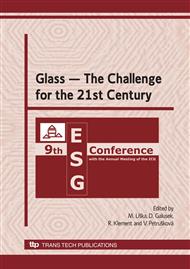p.261
p.265
p.269
p.273
p.279
p.287
p.293
p.299
p.305
Complex Study of E-Glass Corrosion
Abstract:
Both the static and dynamic corrosion tests of E-glass were used for different conditions - temperature, glass surface to solution volume ratio (S/V), solution flow rate (F) and F/S ratio. Results obtained for glass fibres were compared with the ones for glass grains and planar samples. Evaluation of experimental results by kinetic model shows that the change of glass surface should be taken into account in the case of fibres corrosion. The total incongruent process of dissolution could be explained as congruent dissolution of glass accompanied by back precipitation of SiO2 or silicates. In most cases, more then 90% of SiO2 precipitates back. The second possible explanation, i.e. SiO2 network dissolution accompanied by selective leaching of Ca, B and Al, is not very probable. The glass sample shape can influence the estimation of dissolution rate. Up to now, with existing kinetic models, the dissolution rates evaluated from experiments with different shapes of glass (fibres, grains, planar) cannot be used as materials properties.
Info:
Periodical:
Pages:
279-286
Citation:
Online since:
April 2008
Authors:
Keywords:
Price:
Сopyright:
© 2008 Trans Tech Publications Ltd. All Rights Reserved
Share:
Citation:


